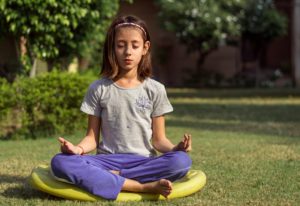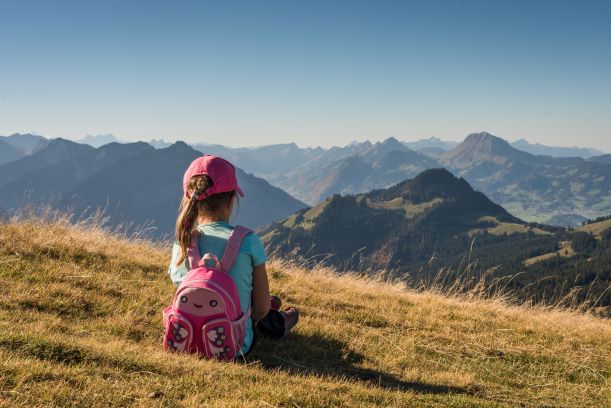From My Classroom to Yours: Supporting ADHD with Mindfulness Techniques
Elliott Buck
Attention Magazine Spring 2017
Download PDF
IT’S JUST ABOUT 2:30 PM and my second-grade students are eager to end our busy day with a closing meditation. This afternoon activity has become a habit and one of our favorite parts of our daily routine.
For the past several years, I have included yoga and mindfulness practices in my second-grade classroom. Practicing mindfulness directly supports and enhances our social-emotional curriculum, but my goal is also to teach students healthy habits and lifelong skills for coping with stress and emotions, and ultimately, for succeeding in life. I believe that practicing mindfulness on a daily basis brings the class together and encourages the students to trust and support one another. Magically, attentional issues disappear, and students become more comfortable taking academic risks, recognizing stress, and self-monitoring their behavior.
Learning to pause, slow down, and be calm
 All children have plenty of extra energy, and it’s valuable to expose them to the healthy ways they can manage that energy. Children who struggle with ADHD have to work even harder to try and harness excess energy that can interfere with the social and academic demands in the classroom. Daily yoga and mindfulness activities can improve self-regulation, confidence, problem-solving, focus, and empathy. Basically, mindfulness teaches us to pause, slow down, and be calm.
All children have plenty of extra energy, and it’s valuable to expose them to the healthy ways they can manage that energy. Children who struggle with ADHD have to work even harder to try and harness excess energy that can interfere with the social and academic demands in the classroom. Daily yoga and mindfulness activities can improve self-regulation, confidence, problem-solving, focus, and empathy. Basically, mindfulness teaches us to pause, slow down, and be calm.
I have seen students, rather than fighting or arguing at recess, walk away from conflict and take a deep breath to manage their emotions. These students might return to the classroom and spend a few minutes resting in child’s pose or meditating on a block to regain composure. In other circumstances, I have had students say, “We need to do some calm breathing and meditation.”
According to psychologists Kirk Strosahl and Patricia Robinson, “Research indicates that brain training involving mindfulness practices can strengthen areas of the brain responsible for attention, emotional control, and problem solving. There is even emerging evidence that mindfulness-based brain training produces permanent structural changes in the brain.”
I am convinced that practicing mindfulness techniques in the classroom directly supports and enhances all students’ learning, and particularly, students who have ADHD. Children who are impulsive can learn to calm themselves and manage their reactions. I have witnessed firsthand students with ADHD using mindfulness skills to make better decisions, control themselves, and, ultimately, find peace during a hectic school day. Mindfulness strategies help these students stay focused, interrupt less, release stress, and quell anxiety. A skill as simple as deep, slow breathing can help these students recognize that they can assert control over their impulses.
Students with ADHD are often known for negative classroom behavior. Mindfulness strategies can help them govern disruptive actions, and at the same time, feel validated and connected to their teachers and classmates. Parents looking for strategies to use at home find our classroom practices very helpful.
 Putting mindfulness on the daily schedule
Putting mindfulness on the daily schedule
Before I committed to practicing mindfulness lessons on a daily basis, I used mindfulness activities only when student behavior was impulsive or out of control. But I’ve found that putting meditation into our daily classroom schedule helps students become consistent in managing their impulsive behaviors. If mindfulness is in the schedule, it’s a non-negotiable routine, just like literacy and math.
The effects of our mindfulness activities extend far beyond our second-grade classroom. Second graders taught seventh graders how to meditate and gave them peace rocks and tips for when they get distracted. Our daily practice has also had positive and profound effects on my students, their families, and my colleagues.
Families have sent me photos of their children meditating in the car, on a beach, and even in the attic with an LED light. Parents report that their children have taught them how to engage in calm breathing in a traffic jam or when they feel hurried in the morning. Parents and grandparents often share that their student led them in a yoga class followed by a guided meditation. Former students have emailed and written me letters about meditation and yoga. Colleagues often ask to join us during meditation.
Students who engage in mindfulness-based meditation feel more self-possessed and connected to their classroom community. With healthy outlets for heady emotions and excess energy, they are better able to focus on and engage in productive learning. My hope is that my students will build the basic foundation for a healthy mind, body, and spirit and establish lifelong healthy habits.
How to Bring Mindfulness to Your Classroom
- Start with one simple mindfulness practice, such as a breathing routine, a yoga sequence, or a guided meditation. Share it with your students and I suspect they will quickly inspire and motivate you! Make the activities you choose fun and light for your students. For example, I give my students “peace rocks” to use while they practice meditation. Any rock will do, but I use smooth, calming rocks I found on my favorite beach in Maine.
- Get some chimes, a singing bowl, or a small gong. I have all of these instruments in my classroom to signal the end of meditation. Students love to use them when they lead the class.
- Schedule a mini yoga sequence. We practice yoga after our morning meeting, always ending in child’s pose. In the beginning of the year, we teachers lead the activities. Students with ADHD tend to get a little silly and out of control at first, but after several sessions I have seen them develop focus and a determination to master tricky poses like crow or eagle. After several weeks, the students delight in leading the mini yoga classes themselves. I often pick the most distracted and wriggly child to go first. I might ask, “What do you need the class to do?” The children usually take this role very seriously. They realize that respect, attention, and self-control are skills you must have if you want to lead the group.
- Make up your own pose. Students love making up their own poses and naming them. Mushroom pose is one of their favorites.
- Take five. We use this simple breathing method when we need to get calm quickly or make smooth transitions between classes. Basically, children take five slow breaths, breathing in through their nose and breathing out through their mouth.
- Mindful walking. To introduce mindful walking, I invite the students to put a block on their head and walk around the classroom. This forces them to walk slowly because they want to keep the block on their head. Once they are comfortable (they become experts right away), we move out into the hallway where, since there is always a lot going on, they need to be extra-focused. We are fortunate to have nature trails at our school. These walks are particularly helpful for kids who have trouble sitting still, and the peaceful, beautiful setting calms and engages us all.
- Meditation. We introduce meditation on the first day of school. We try to get our students intrigued and excited to meditate by making it very simple and fun. During the first few days we set a goal of being still and quiet for one or two minutes with eyes open or closed. We then talk about how they felt before, during, and after. The students are quickly excited to challenge themselves and build their stamina for sitting quietly. We explain to the second graders that there are no right or wrong ways to meditate and that it’s okay if they don’t want to participate, but students are usually eager to join in.
- Even the most restless child can learn to meditate. Students also enjoy back-to-back meditation, where they can feel the support of a classmate. We randomly pick partners to sit back to back and they focus on connecting and syncing with the rhythm of each other’s breathing. Chair meditation is another effective way to calm many students at any point during the school day. While sitting upright in their chairs, students roll their shoulders back, gently rest hands on their lap, and put their feet flat on the floor. Some children comment that they prefer this to a block or the floor because of the support they get from the chair.
- Guided meditation. One of my favorite guided meditation books for children is Imaginations by Carolyn Clarke. This book inspired my second graders to write their own guided meditations. In this type of meditation, a leader—early on, a teacher, and then, individual students—talks the class through the meditation, describing a beautiful and perhaps fantastical setting and offering relaxing suggestions to bring the students to a calm state. You can visit http://vocaroo.com/i/s1u9EesSAuPQ to listen to an example of a guided meditation by one of my students.
- Body scan. We do body scans (seated on a block or lying down), which is when you focus in turn on the different parts of your body, to practice relieving stress. We often start with “Lemon Toes.” The students squeeze parts of their body as tight as a lemon, starting from their toes and moving all the way up to their forehead. They gently release. If they feel tension in any area of their body, we encourage them to breathe into it.
- Block on head. Students balance the yoga block on their head during meditation.
- LED candle. Each student places an LED candle on a block and inhales and exhales to the different colors.
READ MORE
Your Fantastic Elastic Brain: Stretch It, Shape It by JoAnn Deak, PhD, and Sarah Ackerley (Little Pickle Press, 2010).
Mindful Movements: Ten Exercises for Well-Being by Thich Nhat Hanh (Parallax Press, 2008).
Good Morning Yoga: A Pose-by-Pose Wake Up Story by Miriam Gates and Sarah Jane Hinder (Sounds True, 2016).
YogaKids: Educating the Whole Child Through Yoga by Marsha Wenig (Stewart, Tabori, and Chang, 2003).
Imaginations: Fun Relaxation Stories and Meditations for Kids by Carolyn Clarke (CreateSpace Independent Publishing Platform, 2012).
The MindUP Curriculum: Grades PreK–2: Brain-Focused Strategies for Learning—and Living by the Hawn Foundation (Scholastic Teaching Resources, 2012
Elliott Buck, MEd, has over twenty years of experience teaching prekindergarten to third grade in independent schools. She earned her master’s in education at Lesley University. She teaches at the Glen Urquhart School in Beverly, Massachusetts. Elliott brings her passion for yoga, mindfulness, and meditation into the second-grade classroom. Outside of teaching and spending time with her family, Elliott spends her free time collecting rocks at the beach, gardening, playing golf, skiing, and hiking.
Other Articles in this Edition
Teacher to Teacher: Supporting Students with ADHD
From My Classroom to Yours: Supporting ADHD with Mindfulness Techniques
How to Use Homework Apps Effectively
The Top Three Accommodations for Students with EF Problems
How to Talk to Your Child About Your Own ADHD
Failure to Launch: Addressing the Needs of Transition-Age Young Adults
Accountability, Nagging, and Exercise
Preparing for College Challenges [Webinar Guest: Oelking, Michelle]
